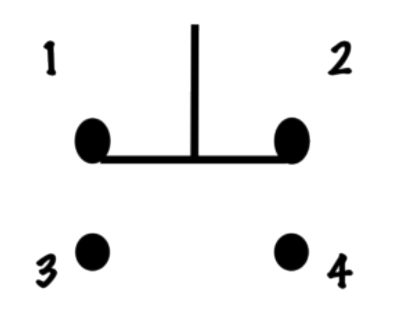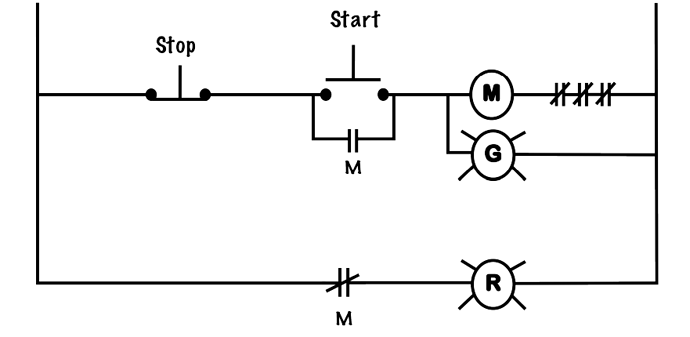Questions
- The minimum number of control circuit conductors to a stop/forward/reverse pushbutton
station that provides low-voltage protection for a three-phase reversible motor is:
A. 2 wires
B. 3 wires
C. 4 wires
D. 6 wires - Which of the following type of motor starter does not normally provide running protection
for the motor?
A. A magnetic starter
148 Chad Flinn and Aaron Lee
B. A pushbutton starter
C. A toggle-switch starter
D. A drum-switch controller - If the circuit in the drawing was operating normally and an overload occurred, then
A. Both lights would come on
B. The green light would come on, and the red light would go out
C. Both lights would go out
D. The red light would come on, and the green light would go out - With a three-wire control circuit, when power is restored after a low voltage situation:
A. The motor will automatically restart after a time delay
B. The motor will automatically restart
C. An operator must restart the motor
D. The motor will polyphase - A melting alloy type of thermal overload is called a:
A. Solder-pot relay
B. Thermal relay
C. Bimetallic relay
D. Dash-pot relay - A starter rated at 10HP, 600 V, if used on a 120V motor would most likely be rated at:
A. 2 HP
B. 3 HP
Basic Motor Control 149
C. 10 HP
D. 2.5 HP - A N.C.T.C contact will be open immediately after the coil is de-energized. True or false?
- An overload relay that uses a strip of dissimilar metals is called a _______ relay
A. Thermistor
B. Melting alloy
C. Solder pot
D. Bimetallic - A shading coil is not required for a DC voltage coil. True or false?
- Overload protection for motors is achieved by connecting:
A. A set of N.C contacts in series with the motor
B. Thermal sensing elements in series with the motor
C. Cartridge fuses in series with the motor
D. A reset relay in series with the motor - The part of a manual AC motor starter which senses motor overload current is the:
A. Overload contact
B. Solder-pot assembly
C. Heater element
D. High-limit switch - The essential difference between a magnetic motor starter and a magnetic contactor is that the
contactor does not contain:
A. Shading coils
B. Holding contacts
C. Overload relay protection
D. Horsepower-rated contacts - The rotation of an AC three-phase induction motor may be reversed by interchanging:
A. The control circuit
B. The forward/reverse interlocks
C. The forward reverse coils
D. Any two power lines - If an AC magnetic contactor with a 480V coil was energized with 120V, then most likely the:
A. Overload relay would trip
B. Contactor would not pick up
150 Chad Flinn and Aaron Lee
C. Control circuit fuses would blow
D. Coil would overheat during normal operation - In a control schematic, a dotted line between two coils generally means that the two coils:
A. Are operated together
B. Are mechanically interlocked
C. Are electrically interlocked
D. Have a common set of contacts - During normal operation, a loud chattering noise is heard from the enclosure of an AC
magnetic starter. What is the most likely cause?
A. Broken shading coil
B. Open in the seal-in circuit
C. Rust on pole faces
D. Power contact is not making good contact due to poor pressure - The purpose of electrical interlocking in a three-phase reversing AC magnetic motor starter is
to:
A. Ensure that the forward direction of rotation is selected first
B. Allow both coils to be energized together
C. Prevent both coils from being energized simultaneously
D. Maintain the coil circuit after the stop button is released - A double-contact pushbutton is illustrated below. When connected as a start button in the
control circuit of a magnetic starter, which pair of terminals are normally used

- A time-delay relay includes both timed and instantaneous contacts. True or false?
- Fill in the missing words. The electrical interlocks on a reversing starter are normally
_______ contacts - A N.O.T.O contact will be closed while the coil of the relay is energized. True or false?
Basic Motor Control 151 - A N.C.T.O designation refers to an off-delay timer. True or false?
- The electrical interlocks in a reversing magnetic starter are:
A. Normally closed contacts
B. Normally open contacts
C. In parallel with the forward and reverse pushbuttons
D. Controlled by the timing relays necessary for circuit operation
Answers - D
- C
- D
- C
- A
- A
- False
- D
- True
- B
- C
- C
- D
- B
- B
- A
- C
- 3 and 4
- True
- Closed
- True
- False
- A
Reference
Basic Motor Control by Aaron Lee and Chad Flinn is used under a CC BY 4.0 Licence.
